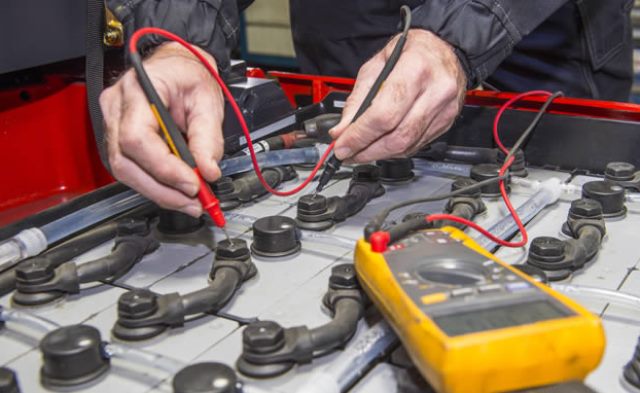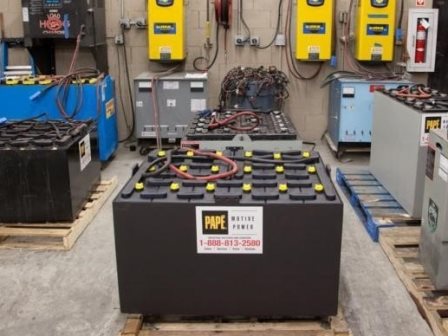What happens if you don’t clean the batteries?
- Battery life can be shortened
- Corrosion can cause battery cells to rupture and leak.
- Metal boxes can corrode
- Electrolytes can damage operator clothing and irritate skin.
- Voltage leaks to ground can create electrical faults.
In addition to routine maintenance, forklift batteries may, at some point in their useful life, require more extensive care.
This care should be given as soon as it has been determined that a problem exists or could be developing.
As a result, this section deals with ways to identify existing or impending problems and offers possible solutions.
If the suggested operational remedies are ineffective, it can be assumed that there is an internal problem and the cell (s) will need to be disassembled to thoroughly inspect the elements and sediment.
If the cause of the problem can only be corrected by completely rebuilding the forklift cells or battery, the designated authorized personnel should be reported.

Forklift Battery Maintenance Guide
Most lead-acid forklift batteries provide around 2,000 charge cycles, which usually translates into about five years of service life. But even this lifespan can only be reached with proper maintenance.
Establish regular maintenance intervals for all industrial batteries to realize the full value of your investment. With the right care, many batteries can last well beyond the length of their warranties, powering forklifts for years past the typical battery lifespan.
There are three essential maintenance tasks that provide reliable service for forklift batteries: watering the cells, washing the battery case, and conducting regular equalization charges. A detailed explanation of each task follows, along with tips to perform each job safely.
Forklift Battery Watering
The battery electrolyte is a mixture of sulfuric acid and water. When water levels get low, the battery’s plates can be exposed to open air. This causes oxidization, which permanently reduces capacity and shortens overall battery life.
In addition to water losses from simple evaporation, the charging process breaks water down into its composite molecules. As hydrogen and oxygen float out of battery vents, the water level within the cells will deplete.
Excessive water loss might be a sign that the battery is gassing more than it should. If you notice a battery losing more water than usual during a charge, have a technician inspect the battery and the charger.
Equalization Charges
Over time, different cells within forklifts may develop slightly different power capacities.
When this happens, users can’t charge batteries to full power; one cell may be fully charged while another only holds a half-charge.
Equalization charges prevent this inefficiency. Essentially, the equalization charge is a purposeful overcharge.
The typical charge cycle lasts about eight hours, while an equalization charge tacks on an additional three hours or so. Chargers continue to provide a low stream of power for those final hours.
Washing Forklift Batteries
There are a few ways that forklift battery electrolyte can escape to accumulate on battery cases:
- As batteries release gas during charges, a fine acidic vapor may drift to the tops of battery cases.
- Agitated electrolytes can spill out of battery vents during the charging process, an occurrence typically known as “boil-over.” Over-watering cells increase the risk of boil-over.
- Batteries may leak electrolytes. If they are stored in tiered racks, and drip pans are not installed or changed regularly, the batteries on the upper levels might drip electrolyte onto those below.
The acidic residue built up on forklift battery cases can cause all sorts of problems. First off, it may create a conductive circuit between lead posts and the steel case. This causes a low-level but constant self-discharge, burning through charge cycles and limiting the lifespan of the battery.
Secondly, acid accumulation can corrode terminals. Damaged terminals may cause electrical problems in lift trucks, as well as limited battery capacity. They might even render a battery unfit for use.
How to reverse battery sulfation?
Undercharging a forklift battery, even to a small degree, if continued, leads to excessive “sulfation.”
The same is true of forklift batteries which have been left standing in an uncharged state for an extended period. High temperatures rapidly accelerate sulfation when forklift batteries are left standing in a partially charged condition.
The cells of a sulfated battery will give low specific gravity and voltage readings. The forklift battery will not become fully charged after a single normal charging when sulfation has taken place over a prolonged period.
If the sulfation has not progressed too far, it may be possible to restore the forklift battery to a serviceable condition by using the following special procedures:
- Thoroughly clean the forklift battery
- Bring the electrolyte level up to a point that is just visible over the separator protector by adding approved water.
- Put the forklift battery on charge at the prescribed finishing rate until the rated ampere-hour capacity has been returned to the forklift battery.
- Place the forklift battery into service and discharge it to a fully discharged condition.
- Charge the forklift battery again until the specific gravity shows no change during a 3 hour period.
- Repeat the cycling process until the specific gravity rises to within 30 points of a normal fully charged forklift battery, then place the forklift battery back in routine service.
How To Repair Electric Forklift Batteries?
A forklift battery can weigh hundreds of pounds and a person may need a forklift to remove it.
Users should check the faulty forklift’s user manual for specific instructions on battery removal and maintenance.
- Upon removal, the user should place the battery in a well-ventilated concrete wash.
- Record the voltage readings, using a voltmeter.
- Check the battery label for an indication of the battery’s voltage.
- Discharge the battery to 80 percent of its labeled voltage.
Battery acid tester
Measuring The Acidity Of The Battery Water:
The user needs to remove the cell caps to access the battery water. Battery water should contain 30 percent sulfuric acid and 70 percent water. Use a hydrometer to measure and record the acidity for each cell. This information indicates how much water or acid the user should add to each cell.
Battery sulfation removal
Sulfation is one of the most common causes of lead-acid battery failure.
While using a battery, small crystals of sulfate form. These are generally not harmful, but when a battery is not charged properly or fully, this lead sulfate turns into a crystalline form that deposits on the battery’s negative plates, forming large crystals.
These reduce the active material in the battery responsible for the low resistance and high capacity and reduce charge acceptance. Charging takes longer due to higher internal resistance.
Users can reverse some types of sulfation. An anti-sulfation or desulfation device applies pulses to the battery terminals to prevent and reverse the process.
These devices tend to reduce sulfation in healthy batteries, but may not be able to completely reverse the condition in damaged batteries. As a preventive measure, use a special desulphation charger to reduce the likelihood of new or good batteries being damaged.

Reconditioned Forklift Battery
Servicing a forklift battery is almost identical to servicing a regular 12-volt automotive battery.

Forklift Battery Service and Maintenance
Maintaining your battery is critical to prolonging the performance and life of your forklift.
